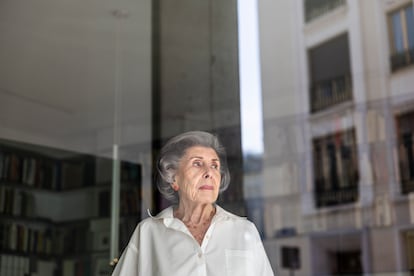Elvira González, gallery owner: "You can't sell your country's shame."

Dressed in white—because when photographs are taken of her, she says she always dresses that way—with coral adorning her ears, neck, and hands, and a dazzling smile, Elvira González (Madrid, 88) displayed her good humor, common sense, and inexhaustible curiosity this Tuesday, hours before receiving the Alberto Anaut Award. The new award recognizes the "decisive work in the professionalization of gallery ownership and the dissemination of modern and contemporary art" of this woman, daughter of a dancer and a sculptor, who triumphed on the stage before making the leap in the 1960s and opening a gallery. She brought Rothko, Calder, and Donald Judd to the gallery and knew how to navigate crises and double down when she decided to go solo. A decade ago, this diehard bullfighting enthusiast passed the reins to her daughters, Elvira and Isabel Mignoni .
Question: A new award, and there are already a few.
Answer: It's a recognition, but also an act of vanity. What Alberto Anaut's award makes me think is that he deserved it because he greatly supported culture.
Q. Are you coming from the Basel fair?
A: It's the first time in 30 years that I've failed. When I started out on my own, they insisted I go, and I asked Helga de Alvear to support me because she was on the committee. They accepted me. I went to thank her, and she said, "Don't thank me. I told them you weren't eligible for work and hadn't even been here two years." She was telling the truth; she was fantastic!
Q. Were women the most supportive of modern art in Spain?
A. That happened. First, Juana Mordó, me, and Juana de Aizpuru, and little by little, it was all women. Maybe because we're more tenacious, persistent, and patient.
Q. What career decision are you most proud of?
A. When I left Theo and went solo. Another important decision was knowing how to backtrack so that my daughters, who are very good at it, wouldn't have Mom nagging them. That's hard.
Q. Who did you learn the trade from?
A. In 1963, when I went to Paris for two years, all I did was go to galleries, salons, and biennials. You learn by observing.

Q. Who gave you good advice?
R. Daniel-Henry Kahnweiler told me I had to be very patient. When we had an exhibition of Spanish artists at the School of Paris, I went to see him because he'd written my Manolo Hugué text. It didn't occur to me that I'd have to pay him. Jean Cassou also wrote a text for me. I always asked the best.
Q. Is it true that they called you Petite Espagnole ?
A. Yes, one of the people who called me that once told him to be careful with Petite Espagnole because I might break his face.
Q. What has been the most important change you have experienced in art?
A. Before, everything was more romantic. Collectors bought because they liked it, and you had to help them evolve. You progress; one artist leads you to another. Art is life and requires observers and artists.
Q: A dancer before becoming a gallery owner. How did you get into dance?
A. Without realizing it, because my mother was already dancing when she was pregnant with me. She danced with La Argentina at the María Guerrero Theater and the Spanish Theater. When I was little, I'd leave school and go with my mother to the theater, and also when I went to rehearse at Pericet's school on Encomienda Street. Whenever I made a mistake, they asked me to join in because I knew it more or less from watching it so often. Later, I learned the bolero school, the barra, and that's how I started.
Q. How did you leave it?
A. When I got married, I couldn't go on. Although I had danced with Pilar López and Antonio Gades, I even toured Thailand. My obsession was and is traveling.
Q. What was your last trip?
R. Nepal and Bhutan.
Q. How do you keep your curiosity alive?
A. I want to see exhibitions and museums and learn. The day you know everything, you're already dead.
Q. How are artists cared for?
A. It's complicated, but you have to accept its uniqueness. My father was a sculptor, I married a painter, and I think I understand the sensitivity and psychology of an artist.
Q. Which Spanish artist are you proud to have supported?
R. I met Esteban Vicente when he was older and I gave him a kick in the pants.
Q. Which painting would you have preferred not to sell?
A. During a terrible crisis, I sold a beautiful Morandi . Eventually, I managed to buy another one.
Q. Do you need to know how to buy and sell?
A. Of course, you sell your possessions to remedy your ills.
Q. Which artist would you have liked to meet?
A. Picasso, but after the attack at the gallery in which his prints were destroyed, I didn't dare. I'm a devotee of Picasso and Miró; I did meet the latter, and he was fantastic.
Q. How do you remember that attack?
A. I was afraid; it was 1971. They sprayed vitriol and smashed everything. I filed a complaint against the Children of Christ the King, who left their pages behind after the attack. We still have the evidence of that destruction. They tried to buy it from me, but you can't sell your country's shame.
Q. Any trips this summer?
A. I'm going to Aix-en-Provence and then to Estonia and Poland.
EL PAÍS




